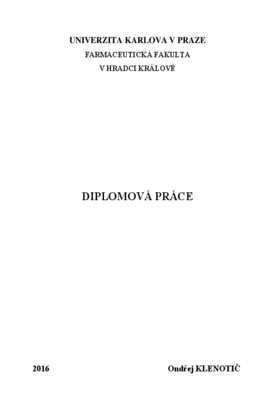Identification and characterization of G protein-coupled nucleotide and nucleotide-like receptors P2Y13 and GPR17
diplomová práce (OBHÁJENO)

Zobrazit/
Trvalý odkaz
http://hdl.handle.net/20.500.11956/74825Identifikátory
SIS: 175151
Katalog UK: 990020909550106986
Kolekce
- Kvalifikační práce [6957]
Autor
Vedoucí práce
Oponent práce
Mladěnka, Přemysl
Fakulta / součást
Farmaceutická fakulta v Hradci Králové
Obor
Farmacie
Katedra / ústav / klinika
Katedra farmaceutické chemie a kontroly léčiv
Datum obhajoby
1. 6. 2016
Nakladatel
Univerzita Karlova, Farmaceutická fakulta v Hradci KrálovéJazyk
Angličtina
Známka
Výborně
Identification and characterization of G protein-coupled nucleotide and nucleotide-like receptors P2Y13 and GPR17 Purinergní receptory jsou rozděleny do třech podskupin, jimiž jsou P1(adenosinové) receptory, P2 (nukleotidové) receptory a P0 (adeninové) receptory. P2 receptory se skládají z ligandem řízených iontových kanálů (LGICs) označených jako receptory P2X1-7 a z receptorů nazývajících se P2Y1,2,3,6,12-14, náležících do skupiny receptorů spřažených s G proteinem, a to do třídy A a její větve značené δ. Receptor P2Y13 je fyziologicky aktivován přes ADP a jeho aktivací se spouští inhibice adenylatcyklasy (Gi). Svou stimulací vykazuje receptor P2Y13 neuroprotektivní účinky. Dále hraje roli též v metabolismu lipoproteinů a transportu cholesterolu v těle. Receptor P2Y13 by tedy mohl být i zajímavým terapeutickým cílem při léčbě atherosklerozy. Receptor GPR17, podobný výše zmíněným nukleotidovým receptorům (nucleotide-like receptor) náleží k početné skupině tzv. orphan receptors, které stále postrádají svého endogenního agonistu. GPR17 je také spřažen s G proteinem (Gi) a jsou mu přisuzovány role v demyelinizačních onemocněních jako je například roztroušená skleroza nebo v některých zánětlivých onemocněních. Vývoj silných selektivních ligandů, agonistů i antagonistů, pro receptor P2Y13 i pro...
Identification and characterization of G protein-coupled nucleotide and nucleotide-like receptors P2Y13 and GPR17 Purinergic receptors are divided into three subfamilies, P1 (adenosine), P2 (nucleotide) and P0 (adenine) receptors. P2 receptors comprise ligand-gated ion channels - shortly LGICs, receptors P2X1-7, and class A, δ-branch GPCRs termed P2Y1,2,3,6,12-14. The P2Y13 receptor is physiologically activated by ADP and coupled to Gi whose activation results in an inhibition of adenylate cyclase. P2Y13 receptor activation has been reported to be neuroprotective. P2Y13 receptors also play a role in lipoprotein metabolism and cholesterol transport, making the receptor an interesting target for the potential treatment of atherosclerosis. The nucleotide-like orphan receptor GPR17, whose endogenous agonist remains still unknown, is also Gi-coupled. GPR17 appears to be involved in demyelinating diseases such as multiple sclerosis, and some inflammatory diseases. The development of potent, selective ligands, agonists and antagonists, for both P2Y13 and GPR17, is required to study their physiological and pathophysiological roles and for validating the receptors as future drug targets. In the present study, we aim to find out, if the approach via β-arrestin assay employing an enzyme complementation is...
